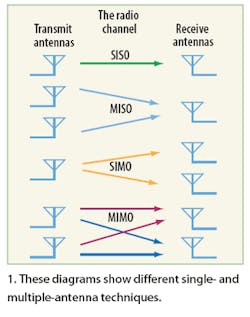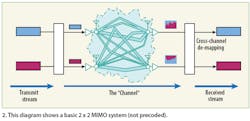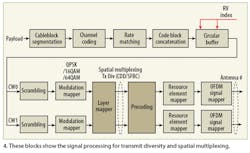Analyze Antenna Approaches for LTE Wireless Systems
This file type includes high resolution graphics and schematics when applicable.
Multiple-input, multiple- output (MIMO) spatial-diversity antenna configurations are specified for emerging 3GPP Long- Term Evolution (LTE) mobile communications systems. In reality, LTE systems specify three types of antenna techniques: MIMO, beamforming, and diversity approaches. The three techniques are considered essential for improving signal robustness and achieving LTE system capacity. Understanding how the different antenna techniques work can also aid in testing systems using these approaches.
Figure 1 depicts simple versions of various antenna techniques. The name given to each technique indicates how the radio channel is accessed by the system's transmitters and receivers. The single-input, single-output (SISO) approach is the most basic radio-channel access mode with one transmitter and one receiver.
The multiple-input, single-output (MISO) mode is slightly more complex, using two or more transmit antennas and a single receive antenna. In a MISO system, which is commonly referred to as a transmit diversity system, the same data is sent on both of the transmitting antennas but is coded in such a way that the receiver can identify each transmitter. Transmit diversity makes the signal more resistant to fading and can improve performance under low signalto- noise-ratio (SNR) conditions. This technique does not directly increase data rates but rather supports current data rates with less power. Transmit diversity can be enhanced with closed-loop feedback from the receiver to indicate the balance of phase and power used for each antenna.
The single-input, multiple-output (SIMO) approach, often referred to as a receive diversity technique, employs one transmit antenna and two or more receive antennas. As with the transmit diversity method, it is well suited for low-SNR conditions, making a theoretical gain of 3 dB possible when two receivers are used. There is no change in the data rate since only one data stream is transmitted.
The MIMO approach requires two or more transmit antennas and two or more receive antennas. This mode is not just a superposition of MISO and SIMO, because multiple data streams are transmitted simultaneously in the same frequency and time, taking full advantage of the different paths in the radio channel. A MIMO system must have at least as many receivers as data streams transmitted. The number of these transmit streams should not be confused with the number of transmit antennas. Consider the transmit diversity (MISO) case with two transmit antennas but only one transmit stream.
Adding receive diversity (SIMO) to MISO does not create a MIMO system, even though there are now two transmit and two receive antennas involved. It is always possible to have more transmitters than data streams but not the other way around. If a number, N, of data streams is transmitted from fewer than N transmit antennas, the data cannot be fully descrambled no matter how many receivers are present. Overlapping data streams without the addition of spatial diversity simply creates interference. However, if the N streams are spatially separated across at least N antennas, N receivers will be able to fully reconstruct the original data streams, provided that crosstalk and noise in the radio channel are sufficiently low not to cause lost data.
For MIMO operation, the transmissions from each antenna must be uniquely identifiable so that each receiver can determine what combination of transmissions it has received. This identification is usually accomplished with pilot signals, which use orthogonal patterns for each antenna. Spatial diversity of the radio channel in this case gives MIMO the potential to increase the data rate.
A basic form of MIMO assigns one data stream to each antenna (Fig. 2).
The channel then mixes up the two transmissions such that at the receivers each antenna sees a combination of each stream. Decoding the received signals is a clever process in which the receivers analyze patterns that identify each transmitter to determine what combination is present. Applying an inverse filter and summing received streams recreates the original data.
A more advanced form of MIMO includes special precoding to match the transmissions to the Eigen modes of the channel. This optimization results in each stream being spread across more than one transmit antenna. For this technique to work effectively the transmitter must have knowledge of the channel conditions and, in some instances, these conditions must be provided in real time by feedback from the user equipment (UE). Such optimization complicates the system but can boost performance.
The theoretical gains from MIMO are a function of the number of transmit and receive antennas, the radio propagation conditions, the ability of the transmitter to adapt to the changing conditions, and the SNR. The ideal case is one in which the paths in the radio channel are uncorrelated, almost as if there were separate, physically cabled connections with no crosstalk between the transmitters and receivers. Because such conditions are almost impossible to achieve in free space, it is neither helpful nor possible to quote MIMO gains without stating the conditions. The upper limit of MIMO gain in ideal conditions is more easily defined, and for a 2 x 2 system with two simultaneous data streams a doubling of capacity and data rate is possible.
MIMO techniques work best in conditions of high SNR with minimal line of sight. Line of sight equates to channel crosstalk and diminishes the potential for gain improvement. As a result, MIMO is particularly suited to indoor environments, which often exhibit a high degree of multipath and limited line-of-sight conditions.
Although the simple depictions of Fig. 1 do not clarify whether multiple transmitters and receivers are used in a MIMO system, details on a few example cases shown in Fig. 3 may help to explain different MIMO setups.
The first case is a singleuser MIMO (SU-MIMO) system, which is the most common form of MIMO and can be applied in the uplink or downlink of a wireless system. The primary purpose of SU-MIMO is to increase the data rate to one user. There is also a corresponding increase in the capacity of the cell. Figure 3 shows the downlink form of a 2 x 2 SU-MIMO system in which two data streams are allocated to one UE. The data streams in the example are coded red and blue, and in this case, are further precoded in such a way that each stream is represented at a different power and phase on each antenna. The colors of the data streams change at the transmit antennas, which is meant to signify the mixing of the data streams. The transmitted signals are further mixed by the channel. The purpose of the precoding is to optimize the transmissions to the characteristics of the radio channel so that when the signals are received, they can be more easily separated back into the original data streams.
Continue on Page 2
Page Title
The second case is 2 x 2 multipleuser MIMO (MU-MIMO), which is used only in the uplink of a wireless system. (MU MIMO, as described in the WiMAX specifications, is called collaborative spatial multiplexing or collaborative MIMO; however, LTE does not use this terminology.) MU-MIMO does not increase an individual user's data rate but it does offer cell capacity gains that are similar to, or better than, those provided by SU-MIMO. In Fig. 3, the two data streams originate from different UE. The two transmitters are much farther apart than in the single user case, and the lack of physical connection means that there is no opportunity to optimize the coding to the channel Eigenmodes by mixing the two data streams. However, the extra spatial separation does increase the chance of the base stationmore specifically, the evolved node B (eNB) element in the radio access networkpicking up pairs of UE that have uncorrelated paths. This maximizes the potential capacity gain, in contrast to the precoded SU-MIMO case in which the closeness of the antennas could be problematic, especially at frequencies less than 1 GHz. MU-MIMO has an additional important advantage: the UE does not require the expense and power drain of two transmitters, yet the cell still benefits from increased capacity. To get the most gain out of MU-MIMO, the UE must be well aligned in time and power as received at the base station.
The third case in Fig. 3 is cooperative MIMO (Co-MIMO). This term should not be confused with the WiMAX collaborative MIMO described above. Co-MIMO involves two separate entities at the transmission end. The example here is a downlink case in which two eNB "collaborate" by sharing data streams to precode the spatially separate antennas for optimal communication with at least one UE. When this technique is applied in the downlink it is sometimes called network MIMO. The most advantageous use of downlink Co-MIMO occurs when the UE is at the cell edge. Here, the SNR will be at its worst but the radio paths will be uncorrelated, which offers significant potential for increased performance.
Co-MIMO could also be used in a wireless system's uplink, but it is fundamentally more difficult to implement since no physical connection exists between the UE to share the data streams. Uplink Co-MIMO without a connection between the UE collapses into MU-MIMO, which does not use precoding. Uplink Co-MIMO is also known as virtual MIMO. Co-MIMO is not part of the 3GPP Release 8 specifications for LTE but is being studied as a possible LTE enhancement in Release 9 or Release 10.
Unlike MIMO, which achieves its highest throughput when the radio channel exhibits uncorrelated transmission paths, beamforming exploits correlation so that the radiation pattern from a transmitter is directed toward the receiver. This is done by applying small time delays to a calibrated phased array of antennas. The effectiveness of beamforming varies with the number of antennas. Little gain improvement is achieved with just two antennas but, with four antennas, considerable improvement in gain is possible.
In theory, a MIMO system can be turned into a beamforming system by changing the precoding matrices. In practice, however, antenna design has to be taken into account and things are not so simple. It is possible to design antennas to be correlated or uncorrelated; for example, by changing the polarization. However, switching between correlated and uncorrelated patterns can be problematic if the physical design of the antennas has been optimized for one or the other.
Since beamforming is related to the physical position of the UE, the required update rate for the antenna phasing is much lower than the rates needed to support MIMO precoding. Thus, beamforming has a lower signaling overhead than MIMO. The most advanced form of multiple antenna techniques is probably the combination of beamforming with MIMO. In this mode MIMO techniques could be used on sets of antennas, each of which comprises a beamforming array. Given that beamforming with only two antennas has limited gains, the advantage of combining beamforming and MIMO will not be realized unless there are many antennas.
For LTE systems, three of the four multiple antenna approaches already described can be used in the LTE downlink: transmit diversity (MISO), receive diversity (SIMO), and spatial multiplexing (MIMO). The first and simplest of these is open-loop transmit diversity. This technique is identical in concept to the scheme introduced in 3GPP UMTS Release 99. The more complex, closed-loop transmit diversity techniques specified for UMTS have not been adopted in LTE. Instead, LTE uses the more advanced MIMO, which was not part of Release 99. LTE supports either two or four antennas for transmit diversity. Figure 4 shows a two-transmitter example in which a single stream of data is assigned to the different layers and coded using spacefrequency block coding (SFBC).
Since this form of transmit diversity has no data rate gain, the code words CW0 and CW1 are the same. SFBC achieves robustness through frequency diversity by using different subcarriers for the repeated data on each antenna.
The second downlink scheme, receive diversity, is mandatory for the UE. It is the baseline receiver capability for which performance requirements will be defined. A typical use is maximum ratio combining of the received streams to improve the SNR in poor conditions. Receive diversity provides little gain in good conditions.
The third downlink scheme is spatial multiplexing, or MIMO, which is also supported for two- and four-antenna configurations. Assuming a two-channel UE receiver, this scheme allows for 2 x 2 or 4 x 2 MIMO. A four-channel UE receiver, which is required for a 4x4 configuration, has been defined but is not likely to be implemented in the near future. The most common configuration will be 2 x 2 SU-MIMO. In this case, the payload data will be divided into the two code-word streams, CW0 and CW1, and processed according to the steps in Fig. 4.
LTE uses the closed-loop form of MIMO with precoding of the data streams, so for the frequency-divisionduplex (FDD) version of LTE the transmitter must have knowledge of the channel. Channel information is provided by the UE on the uplink control channel. The channel feedback uses a codebook approach to provide an index into a predetermined set of precoding matrices. Since the channel is continually changing, this information must be provided for multiple points across the channel bandwidth, at regular intervals, up to several hundred times a second. At this time, the exact details are still to be specified; however, the UE that can best estimate the channel conditions and then signal the best coding to use will undoubtedly get the best performance out of the channel. Although the use of a codebook for precoding limits the best fit to the channel, it significantly simplifies the channel estimation process by the UE and the amount of uplink signaling needed to convey the desired precoding. The precoding matrices for LTE support MIMO and beamforming. Four codebook entries are used for 2 x 2 SU-MIMO and 16 for 4 x 4 SU-MIMO.
In addition to MIMO precoding, there is an option called cyclic delay diversity (CDD). This technique adds antenna-specific cyclic time shifts to artificially create multipath on the received signal and prevents signal cancellation caused by the close spacing of the transmit antennas. Normally multipath would be considered undesirable, but by creating artificial multipath in an otherwise flat channel, the eNB UE scheduler can choose to transmit on those resource blocks that have favorable propagation conditions and apply CDD on a per-UE basis.
For LTE, the baseline UE configuration has one transmitter. It was chosen to save cost and battery power in handheld devices, and can support MU-MIMOthat is, two different UEs transmitting in the same frequency and time to the eNB.
Figure 5 shows the analysis of a transmitted MIMO signal.
Analysis software examines individual antenna ports prior to MIMO encoding to validate the physical layer format and perform individual transmitter tests, such as error-vector-magnitude (EVM). The software can also decode the transmit diversity encoded signal and perform composite EVM by analyzing the output of the combined signal from multiple transmit antenna ports.
This file type includes high resolution graphics and schematics when applicable.






